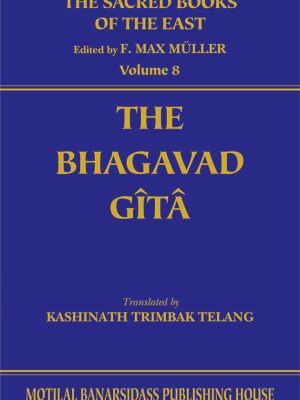Pingal Devayan (Vol. 1): Brahma Kalpa (Vol. 1)
₹995.00
Sold By:
Motilal Banarsidass Publishing House
In stock
Pingal Devayan (Vol. 1): Brahma Kalpa (Vol. 1)
The first volume contains coverage of five different mandalas (books). Pingal Devayan (Vol. 1): Brahma Kalpa (Vol. 1) The Book of the Gods (the Book of the Deva), the Book of the Sages (the Book of the Rishi), the Book of Sacrifice (the Book of Yagna), the Book of Divine Powers (the Book of Biti), and the Book of Pragatha (son of Rishi Kanwa). In Deva Mandala, the manifestation of the epic, the beginning of creation, the births of gods and demons, their battles, the birth of Satyadev, the God of Truth, and the formation of the Time Wheel are all described. In the Rishi Mandala, the life of the sage Vashishta and the devastation caused by the sage Vishwamitra are both recounted in detail. It also discusses the activities of the shadowy powers of the night, known as Nakta, as well as the formation of the psychic entity known as Bitihotra. The Yagna Mandala tells the story of how the wise people asked Agni, the god of fire, for assistance in initiating a sacred sacrifice to call forth Satyadev, the god of truth, who had vanished from the world because of the influence of evil forces. These chants are hymns to the mystic fire, and their purpose is to restore truth to the process of creation. The Biti Mandala is a narrative that describes the capabilities of the celestial deities as well as the cleansing that the Bitihotra provides (psychic being). Following the completion of the cleansing process, the psychic being will identify with the Truth. This takes place in the presence of the holy trinity, which consists of Brahma, Vishnu, and Maheshwara, as well as other godheads, sages, and the four divine energies, which are known as Maheshwari, Mahakali, Mahalakshmi, and Saraswati. The Pragatha Mandala provides an account of Kanwa rishi's family as well as the union of Pragatha, Kanwa's son, and Gathini. They are Kali, the goddess of the Iron Age, who sprang from their offspring. The book goes into great depth about Kali's upbringing and the events that lead to his becoming an anti-god. The tale of the birth of Trita and Dwita, sons of Rishi Aptya, who would limit the impact of Kali in Satyadev's absence is also featured. Trita and Dwita would do this during.
Author
Dr. Hazari
Too Good to Resist Sale is Live BUY AND SAVE NOW
Pingal Devayan (Vol. 1): Brahma Kalpa (Vol. 1)
The first volume contains coverage of five different mandalas (books). Pingal Devayan (Vol. 1): Brahma Kalpa (Vol. 1) The Book of the Gods (the Book of the Deva), the Book of the Sages (the Book of the Rishi), the Book of Sacrifice (the Book of Yagna), the Book of Divine Powers (the Book of Biti), and the Book of Pragatha (son of Rishi Kanwa). In Deva Mandala, the manifestation of the epic, the beginning of creation, the births of gods and demons, their battles, the birth of Satyadev, the God of Truth, and the formation of the Time Wheel are all described. In the Rishi Mandala, the life of the sage Vashishta and the devastation caused by the sage Vishwamitra are both recounted in detail. It also discusses the activities of the shadowy powers of the night, known as Nakta, as well as the formation of the psychic entity known as Bitihotra. The Yagna Mandala tells the story of how the wise people asked Agni, the god of fire, for assistance in initiating a sacred sacrifice to call forth Satyadev, the god of truth, who had vanished from the world because of the influence of evil forces. These chants are hymns to the mystic fire, and their purpose is to restore truth to the process of creation. The Biti Mandala is a narrative that describes the capabilities of the celestial deities as well as the cleansing that the Bitihotra provides (psychic being). Following the completion of the cleansing process, the psychic being will identify with the Truth. This takes place in the presence of the holy trinity, which consists of Brahma, Vishnu, and Maheshwara, as well as other godheads, sages, and the four divine energies, which are known as Maheshwari, Mahakali, Mahalakshmi, and Saraswati. The Pragatha Mandala provides an account of Kanwa rishi’s family as well as the union of Pragatha, Kanwa’s son, and Gathini. They are Kali, the goddess of the Iron Age, who sprang from their offspring. The book goes into great depth about Kali’s upbringing and the events that lead to his becoming an anti-god. The tale of the birth of Trita and Dwita, sons of Rishi Aptya, who would limit the impact of Kali in Satyadev’s absence is also featured. Trita and Dwita would do this during Satyadev’s absence.
Author
Dr. Hazari
About the Author(s)
Dr. Hazari was born in Khulna, now in Bangladesh, on 16 September 1917. Khulna is also the birthplace of Sri Aurobindo. At the age of eighteen, Dr. Hajari followed his Guru, Sri Aurobindo to his Ashram in Pondicherry. He dedicated his life to the ideals of Sri Aurobindo and the Mother and lived there till he passed away on 23 December 1978. He served as a homeopathic doctor and gained fame by healing patients with incurable diseases. Sri Aurobindo’s magnum opus, Savitri, was completed just before the master passed away on 5 December 1950. Three months later, Dr. Hajari had a vision, in which Sri Aurobindo appeared to him. This is how Dr. Hajari became the medium to receive the epic Devayan, a compendium and interpretation of all Indian legends. ABOUT THE TRANSLATOR: Amita Nathwani was born in Dehra Dun, India in 1944. Deeply influenced by Sri Aurobindo, she went to live at Pondicherry in 1963. She is married and since 1973, she is living in Europe. After working In India, Africa and Europe she has decided to dedicate her life to transcribing the twelve volumes of Devayan.
Additional information
| Weight | 0.5 kg |
|---|---|
| Dimensions | 10 × 11 × 12 cm |
| Book Author | Hazari |
Be the first to review “Pingal Devayan (Vol. 1): Brahma Kalpa (Vol. 1)”
You must be logged in to post a review.














Reviews
There are no reviews yet.